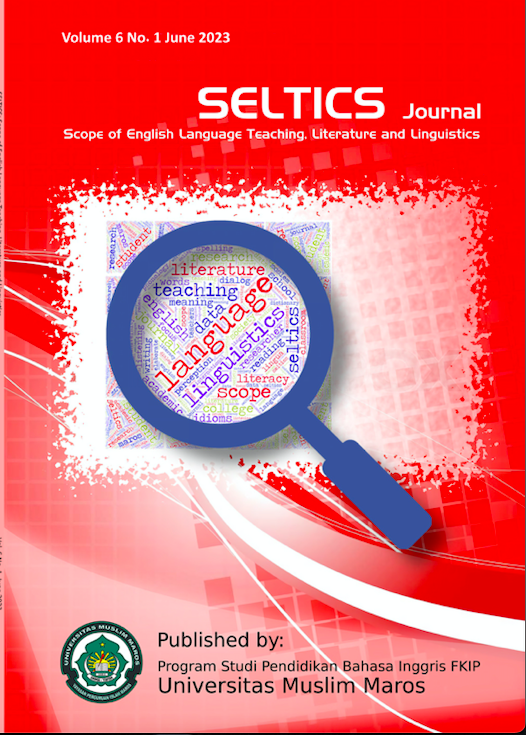Analyzing Errors: An Examination of Simple Present Tense Usage in Descriptive Text
DOI:
https://doi.org/10.46918/seltics.v6i1.1803Keywords:
Error Analysis, Simple Present Tense, Descriptive Text, English Teaching, Student WritingAbstract
This study investigates the common errors made by students when using the simple present tense in writing descriptive texts. The aim of the study is to identify the specific types of errors that occur and to explore the factors contributing to these mistakes. The research adopts a descriptive qualitative method to gather data, employing a written test as the data collection tool. To categorize the errors, a surface strategy taxonomy is utilized, which includes four categories: omission, addition, misformation, and misorder. By analyzing the collected data, a total of 214 errors were identified, with 95 instances of omission errors, 22 addition errors, 75 formation errors, and 22 ordering errors. The findings highlight that the most prevalent type of error made by students is omission, while misformation, misorder, and addition errors are relatively less frequent. In addition to error analysis, the study explores the reasons underlying these errors, particularly focusing on interlingual and intralingual transfer. Interlingual transfer refers to the influence of a student's first language on their second language usage, while intralingual transfer refers to the influence of existing knowledge and patterns within the second language itself. These factors contribute to the occurrence of errors in the simple present tense usage within descriptive texts.
References
Astri, Z. (2018). The Use of Total Physical Response Method for Different Learning Styles in English Vocabulary Development. SELTICS, 1(1), 25-38.
Astri, Z., & Fian, A. (2020). The Sociolinguistics Study on the Use of Code Mixing In Gita Savitri Devi’s Youtube Channel Video. SELTICS, 83-92.
Astri, Z., Noer, F., & Wahab, I. (2022). The use of WhatsApp in learning English during pandemic Covid-19: Students’ perception. Journal of Teaching and Education for Scholars, 1(1), 47-53.
Astri, Z., Nur, S., & Misnawati, M. (2022). Need analysis of pharmacy students in TOEFL preparation class. VELES: Voices of English Language Education Society, 6(1), 1-13.
Astri, Z., & Wahab, I. (2018). The Effect of Reading Teaching Material for Different Learning Styles in Improving Students’reading Comprehension. Jurnal Bahasa Lingua Scientia, 10(2), 215-230.
Astri, Z., & Wahab, I. (2019). The Use of TPR Method for Disable Students With Different Learning Styles in English Vocabulary Development. SELTICS, 2(2), 66-75.
Azar, Betty Schrampfer. (1989). Understanding and Using English Grammar. Second Edition. New Jersey: Prentice Hall.
Baehaqi, I. (2005). Practical English Grammar. Yogyakarta: Pustaka Pelajar.
Brown, H. Douglas. (2000). Principles of Language Learning and Teaching. Longman, San Francisco State University.
Callaghan, M., and Rothery J.(1998).Teaching Factual Writing. Sydney: Metropolitan East Disadvantaged School Program.
Dulay, Heidi. (1982). Language Two. New York: Oxford University Press.
Ellis, R. (1994). The Study of Second Language Acquisition. London: Oxford University Press.
Johansson. (1975). The Uses of Error Analysis and Contrastive Analysis (II). ELT J (1975) XXIX(4): 330-336 doi:10.1093/elt/XXIX.4.330.
Maleong, Lexy J. (2004). Metodologi Penelitian Kualitatif. Bandung: PT. Remaja Rosdakarya.
Noprianto, E. (2017). Students’ Descriptive Text Writing in SFL Perspectives. IJELTAL (Indonesian Journal of English Language Teaching and Applied Linguistics), 2 (1), 66- 6.
Norrish, J. (1983). Language Learners and Their Errors. London and Basingstoke: The Macmillan Press Limited
Richard, J. C. (1984). Error Analysis: Perspective on Second Language Acquisition. New York: Addison Wesley Longman Limited.
Syamsir, N. F., Astri, Z., Suhartina, S., & Noer, F. (2021). Improving reading comprehension skill through Listen-Read-Discuss (LRD) learning strategy. Journal of Science and Education (JSE), 1(2), 60-71.
Toago, A. P., Usman, S.,& Mukrim. (2013). The Ability of Students to Apply Present Tense ain Writing Descriptive Text. E-Journal of English Language Teaching Society (ELTS). 1 (2), 1-3.
Wahab, I., & Astri, Z. (2022). Students’ Interest in Using Semantic Mapping Technique in Learning English Writing Ability. Journal of Indonesian Scholars for Social Research, 2(1), 68-71.
Werner, P. K., & Sapventa, L.(2002).Mosaic 1 Grammar, 4th Edition. New York: McGrawHill.
Widiati, U.,& Cahyono, B. Y. (2006). The Teaching of EFL Writing in The Indonesian Context: The State of The Art. Jurnal Ilmu Pendidikan.13 (3), 139- 140
Wishon, G. E., & Burks, J. M. (1980). Let's Write English. New York: Litton Educational Publishing, Inc.









